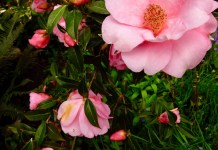
Plants for Pollinators, Info for Gardeners
No doubt, I am the largest, most flightless, furless bumblebee around, but a man’s got to do what a man’s got to do, especially if he wants peaches in the Pacific Northwest. So with dry paintbrush in hand, I visit my peach trees each spring and try to coax them into a little hanky-panky with another tree’s not-so-private parts, all for the promise of some fruit at summer’s end. (Here’s that story: He’s a Cool Pollinator.)
The trouble is I must face reality. As prodigious a pollinator as I am, Mother Nature still does a much, much better job, especially when given a fighting chance. Native pollinators, everything from birds to bees to butterflies to beetles, play a vital role in sustaining our food supply and native plants. How can you help? There are countless ways. I heartily recommend checking out this really amazing non-profit site Pollinator Partnership where experts share ways to attract pollinators and the steps you can take to improve pollinator habitat in your neck of the woods.

Visit the first link below and submit your zip code to see the informative guide for your area (and it’s downloadable, too).
Great Pollinator Partnership Links:

It is imperative that we take immediate steps to help pollinator populations thrive. The beauty of the situation is that by supporting pollinators’ need for habitat, we support our own needs for food and support diversity in the natural world. –Laurie Davies Adams, Pollinator Partnership
Happy Gardening! And take a little time to learn how you can protect and pamper your pollinators by visiting the Pollinator Partnership.







Very cool (and who knew? My western NY zip shares a zone with the upper Midwest and northeastern Maine.) I hand pollinate a few things–the glass gem corn I grow and which I guard zealously, and some of the winter squashes from an unusually large and unabashedly promiscuous patch that I maintain–some I try to save for seed, and some I’m trying to invent new varieties. Here we’re less than a month out from our last frost, so there are still scant blossoms in the garden but already I’ve noticed there seem to be fewer than usual pollinators around. Could the double-dip of last winter’s polar vortex also be to blame? As worrisome is the fact that we’re just a few hours west of ground zero for the white nose fungus that’s been wiping out our bat colonies, and there are definitely fewer of those around these past couple of years; even the colony that had taken up residence in my attic awhile back has disappeared.
Anne, I love hearing about what’s going on in other parts of the world. Your garden sounds great, especially interested to hear about any new dreamy pumpkins you come up with. Do you grow the glass gem corn as an ornamental or do you eat it, too? Dried and ground, or fresh eating? Here’s a link I found, as I wanted to learn more: http://www.nativeseeds.org/community/199-the-story-of-glass-gem-corn-beauty-history-and-hope.
I sold a bunch of mine, and I think it’s a popcorn (though I haven’t tried that yet). But it was so beautiful I was happy to have it all hanging in my house through the fall and winter as it dried. I’m cultivating it here to try to get it well adapted to this climate, where corn is happy to grow anyway. I also think that the amount of seed stock available out there is a bit limited still. I’m happy to send you some seed, if you like; message me on facebook. I’ll post a couple of photos of the crop from last year there and tag your page in them, so you can see.